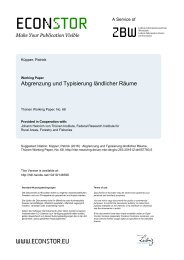their Geographical Neighbourhood
n?u=RePEc:eiq:eileqs:97&r=all
n?u=RePEc:eiq:eileqs:97&r=all
Create successful ePaper yourself
Turn your PDF publications into a flip-book with our unique Google optimized e-Paper software.
Location Strategies of EU-15 MNEs in the European Neighborhood<br />
institutions play a highly significant role in shaping greenfield investment<br />
decisions after controlling for other economic characteristics of the host<br />
economies, showing significant heterogeneity in MNEs’ preferences over<br />
different institutional settings both by sector and by function of the MNE.<br />
The paper is structured as follows: Section 2 provides an overview of the relevant<br />
literature on MNE location behaviour and on the role of economic institutions in<br />
attracting foreign investors, identifying the main research questions and<br />
hypotheses to be tested. Section 3 describes data and variables used in the<br />
analysis, and provides some descriptive evidence about the location of European<br />
foreign investment in the group of countries of interest and <strong>their</strong> institutional<br />
conditions. The methodology is discussed in Section 4, while Section 5 presents<br />
the empirical results. Finally, some concluding remarks and tentative policy<br />
implications are drawn in Section 6.<br />
2. MNEs location strategies, host economy advantages and<br />
institutional conditions<br />
2.1. MNEs and host economy advantages<br />
The analytical framework for the analysis of MNE location decisions is Dunning<br />
(1977, 1988)’s Ownership-Location-Internalisation (OLI) eclectic paradigm. The<br />
OLI framework implies that the existence of ownership-specific advantages (O)<br />
possessed by some firms may lead to the decision to internalise (I) activities and<br />
4




